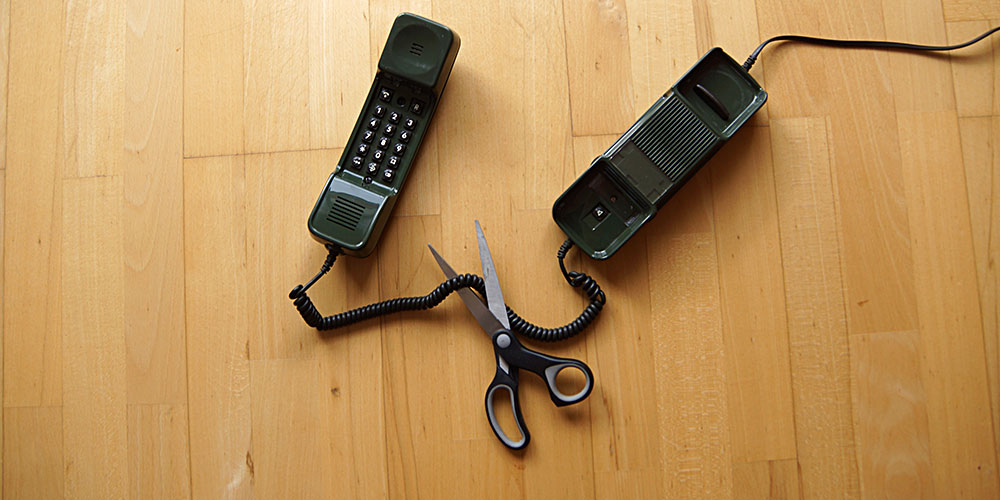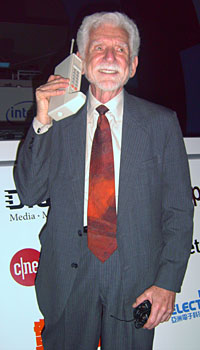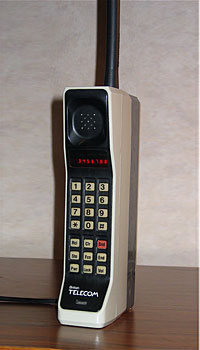How the telephone lost its cord

First mobile call
 On April 3rd 1973 Motorola manager Martin Cooper made a phone call with
On April 3rd 1973 Motorola manager Martin Cooper made a phone call with
 Joel Engel, head of the cellular program at AT&T. Cooper stood on Sixth Avenue in New York with
a cellphone prototype from Motorola. Via the first cell the call was transferred into the fixed line
network which effectively demonstrated the new technique. On 21st September 1983
Motorola's first cellphone named
DynaTAC 8000X (see photo on the right)
received admission from FCC and started to be
sold. In spite of its 800g weight, its size of 33x4,5x9cm, the low battery life of under one hour and
its hefty prize of initially $3,995 it was bought more than 300.000 times during the first year.
Joel Engel, head of the cellular program at AT&T. Cooper stood on Sixth Avenue in New York with
a cellphone prototype from Motorola. Via the first cell the call was transferred into the fixed line
network which effectively demonstrated the new technique. On 21st September 1983
Motorola's first cellphone named
DynaTAC 8000X (see photo on the right)
received admission from FCC and started to be
sold. In spite of its 800g weight, its size of 33x4,5x9cm, the low battery life of under one hour and
its hefty prize of initially $3,995 it was bought more than 300.000 times during the first year.
Like many inventions this had also a military history. Like Nokia also Motorola produced
walkie-talkies for the army and later on for the police. At Motorola this success story started with
the Handie-Talkie, a radiotelephone for the parachutist in World War II. Later on it was enhanced
for police radio.
Martin Cooper noted later that Motorola recognized the deficits of the car phones early and they
heard from the police that they had a desire for a mobile device. “People did not want to be
chained to the walls, or stuck in their cars or homes; they liked to move around. We built radios
and pagers and saw how they became everyday objects the smaller they became.
That's how you build a religion, a business religion and the essence of that religion is that
no thing can be too small or too light.”
Handover
A lot more complicated was the research on how a phone can move from cell to cell. Motorola adopted the 1946 patented idea of a radio cell from Bell Labs and developed the handover where the cellphone is passed to the next cell when the reception level permits this. In 1977 the first mobile network was established between Washington D.C. and Baltimore but only in 1978 the FCC reserved the needed frequency bands for cellular communication. With the admission of the first cellphone, the DynaTAC 8000X, the success began in 1983. “The people accepted it at once. They had seen it on Star Trek and other science fiction movies. While other science was hard to understand the people saw the benefit immediately.”, Don Linder, responsible for the sale of the DynaTAC remembers.
Marketing
From the very beginning Motorola used a dual strategy in its marketing: One campaign targeted business men which are traveling a lot and suffer from expensive telephone bills in hotels while the other campaign targeted housewives which want to stay in touch with their families and friends while shopping. Motorola benefited from its experience selling fixed line phones: They started as business devices but only became a mass market in the US when they addressed the communication needs of housewives.
Standardizing
Another step while developing cellular communication was the
early work standardizing the technique which began as early as 1982. Only with the GSM standard the mass market could develop, also in Germany. In this country
GSM based cellular networks started in 1992, 19 years after the first call. The first cellular
phone from Motorola which still looked a lot like the
DynaTAC 8000X was the ![]() Motorola International 3200.
Motorola International 3200.
Milestones
| Year | Picture | Brand | Model | Wireless Standards | Characteristics |
|---|---|---|---|---|---|
| 1973 |  |
Motorola | DynaTAC Prototyp | proprietary | First experimental cellphone |
| 1983 |  |
Motorola | AMPS | First commercially available cellphone | |
| 1992 |  |
Motorola | GSM 900 | First GSM cellphone | |
| 1992 |  |
Nokia | GSM 900 | First Nokia GSM cellphone | |
| 1994 |  |
e-plus | GSM 1800 | First GSM 1800 cellphone | |
| 1994 |  |
IBM | AMPS | First Smartphone and first cellphone with touchscreen | |
| 1995 |  |
Siemens | GSM 900 | First cellphone with SMS | |
| 1996 |  |
Nokia | GSM 900 | First Nokia smartphone | |
| 1997 |  |
Motorola | GSM 900 | First GSM clamshell and first cellphone with vibrating alert | |
| 1997 |  |
Siemens | GSM 900 | First cellphone with 4-color-display | |
| 1997 |  |
Motorola | GSM 900/1800 | First GSM dualband cellphone with manual switch between GSM 900 and 1800 | |
| 1998 |  |
Motorola | GSM 900/1800 | First GSM dualband cellphone with automatic switch between GSM 900 and 1800 | |
| 1999 |  |
Siemens | GSM 900/1800 | First cellphone with graphic display | |
| 1999 |  |
Nokia | GSM 900/1800 | First cellphone with WAP | |
| 1999 |  |
Toshiba | PDC | First cellphone with camera | |
| 2001 |  |
Ericsson | GSM 900/1800/1900 | First cellphone with Bluetooth | |
| 2001 |  |
Ericsson | GSM 900/1800/1900 | First cellphone with 256-color-display | |
| 2001 |  |
Nokia | GSM 900/1800 | First cellphone with FM radio | |
| 2002 |  |
Nokia | GSM 900/1800 | First cellphone with integrated VGA camera | |
| 2002 |  |
SonyEricsson | GSM 900/1800/1900 | First cellphone with MMS | |
| 2003 |  |
Sharp | GSM 900/1800 | First cellphone with 65.000-color-display | |
| 2003 |  |
SonyEricsson | GSM 900/1800/1900 | First cellphone with color touchscreen | |
| 2003 |  |
Motorola | UMTS GSM 900/1800/1900 |
First UMTS cellphone | |
| 2004 |  |
SonyEricsson | GSM 900/1800 | First cellphone with front camera | |
| 2006 |  |
LG | GSM 900/1800/1900 | First cellphone with 5 megapixel camera | |
| 2007 |  |
Apple | GSM 850/900/1800/1900 | First smartphone with finger operated Multitouch-screen | |
| 2008 |  |
Apple | UMTS GSM 850/900/1800/1900 |
First iPhone with UMTS | |
| 2008 |  |
HTC | UMTS GSM 850/900/1800/1900 |
First Android smartphone | |
| 2010 |  |
Nokia | UMTS GSM 850/900/1800/1900 |
First smartphone with 12 megapixel camera | |
| 2010 |  |
Nokia | UMTS GSM 850/900/1800/1900 |
First smartphone with 41 megapixel camera | |
| 2010 |  |
HTC | LTE UMTS GSM 850/900/1800/1900 |
First LTE smartphone | |
| 2010 |  |
Vivo | LTE UMTS GSM 850/900/1800/1900 |
First Smartphone with in-display fingerprint sensor | |
| 2012 |  |
Nokia | LTE UMTS GSM 850/900/1800/1900 |
First smartphone with Qi | |
| 2018 |  |
Motorola | 5G LTE UMTS GSM 850/900/1800/1900 |
First 5G smartphone (by use of add-on module) | |
| 2019 |  |
Meizu | LTE UMTS GSM 850/900/1800/1900 |
First smartphone without keys & connections | |
| 2023 |  |
Apple | 5G LTE UMTS GSM 850/900/1800/1900 |
First smartphones with Qi2 | |
| 2024 |  |
HMD | 5G LTE UMTS GSM 850/900/1800/1900 |
First Android smartphone with Qi2 |
Recommended Links
![]() The Skyynet cellphone database shows all cellphones with their data
The Skyynet cellphone database shows all cellphones with their data


